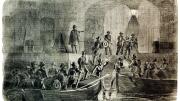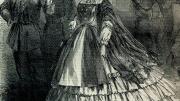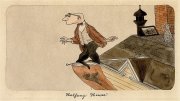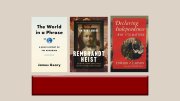We are in the midst of a perfect storm of new Civil War books. With the bicentennial of Abraham Lincoln’s birth in 2009 and this year’s sesquicentennial of the beginning of the conflict itself, historians have kicked into overdrive, threatening to overwhelm even the most voracious readers. Still, Adam Goodheart’s engrossing 1861: The Civil War Awakening will not be lost in the crowd. Many already know Goodheart from his frequent--and these days, it seems, almost daily--historical pieces in the New York Times, but this book permits him to demonstrate the full range of his narrative powers.*
Its title notwithstanding, the book is actually the history of 10 crucial months across two calendar years, October 1860 to July 1861, as the nation--soon to become two nations--teetered on and then crossed over the verge of revolution. Rather than begin his story with the firing of the first shot on April 12, Goodheart purposefully opens his book months earlier as Major Robert Anderson raises the Union flag over Fort Sumter, in Charleston Harbor, following his garrison’s secret removal to the fort in the dead of night, under the noses of hostile and heavily armed South Carolinians. Goodheart’s reasons for doing so say much about the book as whole.
For one, he wants to give the United States, not the Confederate States, the initiative in the forthcoming struggle for national existence. Accounts that begin with the first shot, he maintains, make the “Union side into simply the passive target of the Confederacy’s aggression” and tend to glorify “the ‘lost cause’ at the expense of the one that would win.” Goodheart’s book is certainly not guilty of that, for though white Southerners do inhabit his pages, his primary interest and sympathy lie with those who would wear the blue, not the gray.
And Goodheart wants above all to emphasize the extreme uncertainty of these troubled days. The exchange of cannon fire in April would bring war, but also clarity to a very murky situation. It is the murkiness that he relishes. He is less interested in advancing a new argument or uncovering new evidence than in trying to recapture a unique moment, a feeling, a sense of fundamental crisis. His is a story of possibility--of terrifying, revolutionary possibility “when almost everything hung in the balance.” That tension is palpable on every page.
In telling such a large story, Goodheart faces some very real challenges, and his greatest achievement is his ability to contain this chaotic period within a coherent and masterfully written narrative. The “full story” of the beginning of the Civil War, he tells us, is not to be found in Charleston and Washington alone. Rather, “it is necessary to go much farther afield: to the slums of Manhattan and the drawing rooms of Boston, to Ohio villages and Virginia slave cabins, and even to the shores of the Pacific.” Hence, each chapter opens in a different locale, as Goodheart takes readers on a whirlwind tour of Civil War America (the northern two-thirds of it at any rate). By looking beyond the East Coast, and especially by incorporating events on the frontier and California, he brings a valuable new perspective to the crisis--that of fretful western Americans who watched, waited, and, in some cases, schemed from the other side of the continent.
But while the geographical sweep of the book is expansive, the focus is very much on the specific--on individuals. At heart, Goodheart is a storyteller, and the stories that fascinate him are those of “how individual Americans--both ordinary citizens and national leaders--experienced and responded to a moment of sudden crisis and change as it unfolded.” The book explores the greatest crisis in American history from the perspectives of well-chosen representative men and women who are not just the usual cast of characters. Abraham Lincoln, Robert Anderson, and other key political and military leaders are here, of course, but so are the craggy 104-year-old Mainer and American Revolutionary War veteran Ralph Farnham; the cerebral and idealistic James Garfield; the runaway, recaptured, and then ran-away-again Virginia slave Lucy Bagby; the indomitable and brilliant Jessie Benton Frémont; the flamboyant and ill-fated Elmer Ellsworth.
Goodheart is the master of the poignant vignette. In the anecdote that opens chapter 2, for instance, he unpacks an 1861 advertisement in the Daily National Intelligencer announcing the public sale of “One Negro man” and “Also, one Gold Watch” to reveal the details of how this unfortunate slave, Willis, came to find himself on the auction block following the death of his master, a longtime Washington fixture, Judge George M. Bibb. The writing here beautifully illustrates the injustice and the callousness of slavery even in places like the nation’s capital, where it supposedly had been abolished.
Using small incidents like Willis’s sale, Goodheart explores the larger historical context surrounding his figures, and in so doing seamlessly incorporates political, social, economic, cultural, and intellectual history into his narrative. For the lay reader, he provides a reasonably comprehensive treatment of the salient themes and issues of the late antebellum period. But his greatest contribution lies in his ability to recreate the texture, the sharp detail, of the everyday life and experience of nineteenth-century Americans. He demonstrates well the strengths of narrative history at its best: its accessibility, its artistry, its ability to engage readers intimately with the past, its capacity to synthesize a tremendous range of materials and voices, its expansive vision, its seductively authoritative perspective.
But there are limits to narrative history. By their very nature, narratives are progressive and linear. With the benefit of hindsight, they impose a trajectory on the past. This is what makes them so compelling, but it can also lead to distortion. In Goodheart’s case, his story is of the beginning of something--a “Civil War Awakening”--which prompts the question: the beginning of what? In answering it, he understandably gets a little ahead of himself. Northern victory, emancipation, and a “new birth of freedom” for a greatly strengthened and united American nation seem almost foregone conclusions by July 1861 in this telling. Goodheart can hardly be criticized for foreshadowing--the very title of his book demands it--but it must be pointed out that there is a certain degree of ahistorical distortion at work here, and it is ironic--given his passion for highlighting the uncertainty and revolutionary nature of the conflict’s early days--that the book tends to downplay the contingency and revolutionary impact of the cataclysmic events that would follow.
That caveat aside, Goodheart’s book is an impressive accomplishment, a delightful read, and a valuable contribution that will entertain and challenge popular and professional audiences alike. Even for those of us very familiar with the period and the events and figures he describes, it is refreshing to have them presented in this fashion, and Goodheart’s narrative draws connections that might otherwise be missed.
Michael T. Bernath, Ph.D. ’05, is Tebeau assistant professor at the University of Miami and the author of Confederate Minds: The Struggle for Intellectual Independence in the Civil War South (University of North Carolina Press, 2010).
*A former Undergraduate columnist for this magazine, Adam Goodheart ’92 now directs the Starr Center for the Study of the American Experience, at Washington College.
Adam Goodheart ’92, 1861: The Civil War Awakening (Knopf, $28.95)









